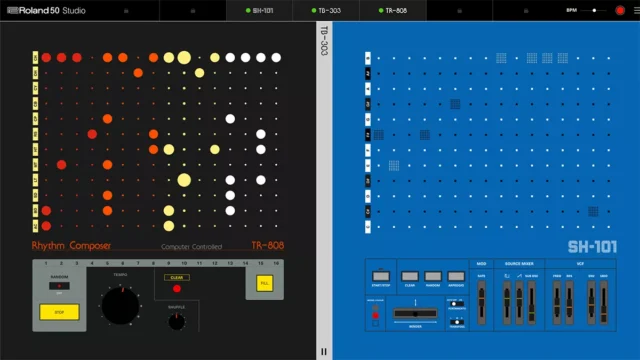Learning About Analog and Digital Instruments From Around the World
Digital Instruments | Lesson 2
This is a series of lessons on the origins of instruments and drum machines. These lessons lead students on an exploration of analog drums, percussion instruments and digital instruments from around the world. Part 1 covers analog percussion instruments from around the world and Part 2 (below) focuses on digital instruments.
Age: 3-15 (younger students may not be able to use tablet-based synthesizers in the digital lesson)
(digital instrument lesson)
Location: Indoor activity.
Lesson duration: ~45 minutes per lesson
Number of students: Class 2-8 or large group 2-25 Children
Students should be organized based on the amount of computers/tablet synthesizers available. Larger classes should be organized into groups of 2-4 students.
Rationale: Children love music, and they respond best to musical experiences when they actively participate in them. For this reason, it’s important to expose kids to a range of musical instruments including modern electronic instruments so they can experiment and make music. Children might not be aware of the cultural context that musical instruments have, but this is an excellent opportunity to educate kids to the musical sounds of various countries.
Introducing students to beat-making using cloud-based digital instruments enables them to learn and incorporate the basics skills of computer programming into a project using a medium that is compelling and accessible on laptops and iPads that are available in most classrooms.
Objectives:
- Encourage children to appreciate diverse musical sounds.
- Learn about music traditions from other cultures, gaining an understanding and appreciation for diversity.
- Teach children about belonging to a wider world.
- Gain musical aptitude, awareness and confidence.
- The students will explore the differences between analog and digital
Exploring Digital Instruments
Main Component of Lesson part 2:
Understanding the development of modern drum machines like the Roland TR-808 is important. The TR-808 was not a financial success when it was originally introduced by the Japanese company Roland, and like many misunderstood geniuses, the 808 was derided for having unrealistic drum sounds. It’s funny how the 808 has now developed a distinct identity as a drum sound and is now noted as one of the most important innovations in popular music.
Watch the video by A Guy Called Gerald on how to use the 808 drum machine app.
The following is a description of the method of use, sound and cultural context of a variety of popular, and developmentally appropriate musical instruments for children aged between 3-15 years of age:
Provide background and context for the lesson. Play the music electronic instruments that the students will be learning about.
TR 808
Here are 7 classic songs made using the TR-808, that helped solidify its status as one of the most important innovations in popular music.
1. Marvin Gaye- “Sexual Healing”
2. Afrika Bambaataa- “Planet Rock” (TR-808: Drums, Micromoog: Bassline, Percussions)
3. Egyptian Lover- “Egypt, Egypt”
4. Whitney Houston- “I Wanna Dance With Somebody”
5. Run DMC- “It’s Tricky”
6. Outkast- “The Way You Move”
7. Kanye West- “Love Lockdown”
8. Future- “March Madness” (Explicit Lyrics)
TR-808 Tracks
Play a few songs that use the 808 Drum machine or play the demo above. Hip Hop has been known for featuring the 808 but House music and Detroit Techno used this drum machine even more. For example, A Guy Called Gerald’s group 808 State best known for the song “Pacific State” (played on a Roland Juno-106) and he also created the song “Voodoo Ray” using the 808.
TR-909
Jeff Mills 909 Demo – The Exhibitionist
TR-909 Tracks
With the students sitting in small circle pick an instrument from the electronic instruments (Roland 50 Studio or 808303.studio). If you have a larger class organize students into small groups around the classroom have each group pick an instrument from the electronic instruments that are available on the app (Roland 50 Studio or 808303.studio).
Next demonstrate how the instrument can be played following the videos instruction shown in the video. Demonstrate the sounds it makes, and discuss the analog instrument originates from, or ask students what the sound of the electronic instruments reminds them of.
If only one tablet computer / laptop is available, have the students pass it to the child nearest to them and ask them to explore the digital instruments for themselves, passing it along after they are done to the next student or group of students (help with turn taking may be needed for very young children).
If there are enough devices, place student in small groups assign each group a different instrument / drum machine and allow each group of students to have some time creating compositions. Next, allow each group to play their composition and discuss or explore the compositions as a group.
Conclusion:
At the end of the lesson debrief and reflect with the children on their experience and what they learned. Ask and discuss:
- Allow students to volunteer to play their new tracks
- Favorite instruments and why?
- Which instruments produced a loud or soft sound?
- How did you play (each particular instrument)?
- Compare and contrast the sounds of analog and digital instruments
Resources:
- Roland 50 Studio (http://Roland50.studio) App
(This app works well on iPads or tablet computers but provides a wide range of drum machines and synthesizer emulators) or the Roland 808303.studio (https://808303.studio) App (This app is better for use on PC’s or laptops but only offers a 303 synth and 808 Drum Machine)
Assessment:
The student will be able to:
- Engage in the activity and participates in exploring sound
- Use the instrument appropriately as demonstrated but create their own interpretation in creative play
- Able to produce different rhythms, beats and/or Basslines
- Can name the country of origin representing the electronic instruments?
Extension Activity:
Ask children to pick their favorite instrument and create their own rhythm patterns. Play and teach children about other songs using these electronic instruments from different genres (Hip Hop, Bangra, Reggaeton) and countries, including exposure to different languages.
Educational framework: (VEYLDF 2009).
Outcome 1: Identity- Respond to ideas and suggestions from others. Increasingly cooperate and work collaboratively with others.
Outcome 2: Community- Cooperate with others and negotiate roles and relationships in play episodes and group experiences. Broaden their understanding of the world in which they live.
Outcome 3: Children have a strong sense of well-being- Manipulate equipment and manage tools (instruments) with increasing competence and skill.
Outcome 4: Children are confident and involved learners- Manipulate objects and experiment with cause and effect, trial and error, and motion.
Outcome 5: Use the creative arts such as music to express ideas and make meaning. Experiment with ways of expressing ideas and meaning using a range of media.
(Resource Credit: Excerpted from Grenoble Studio of Musical Arts).


